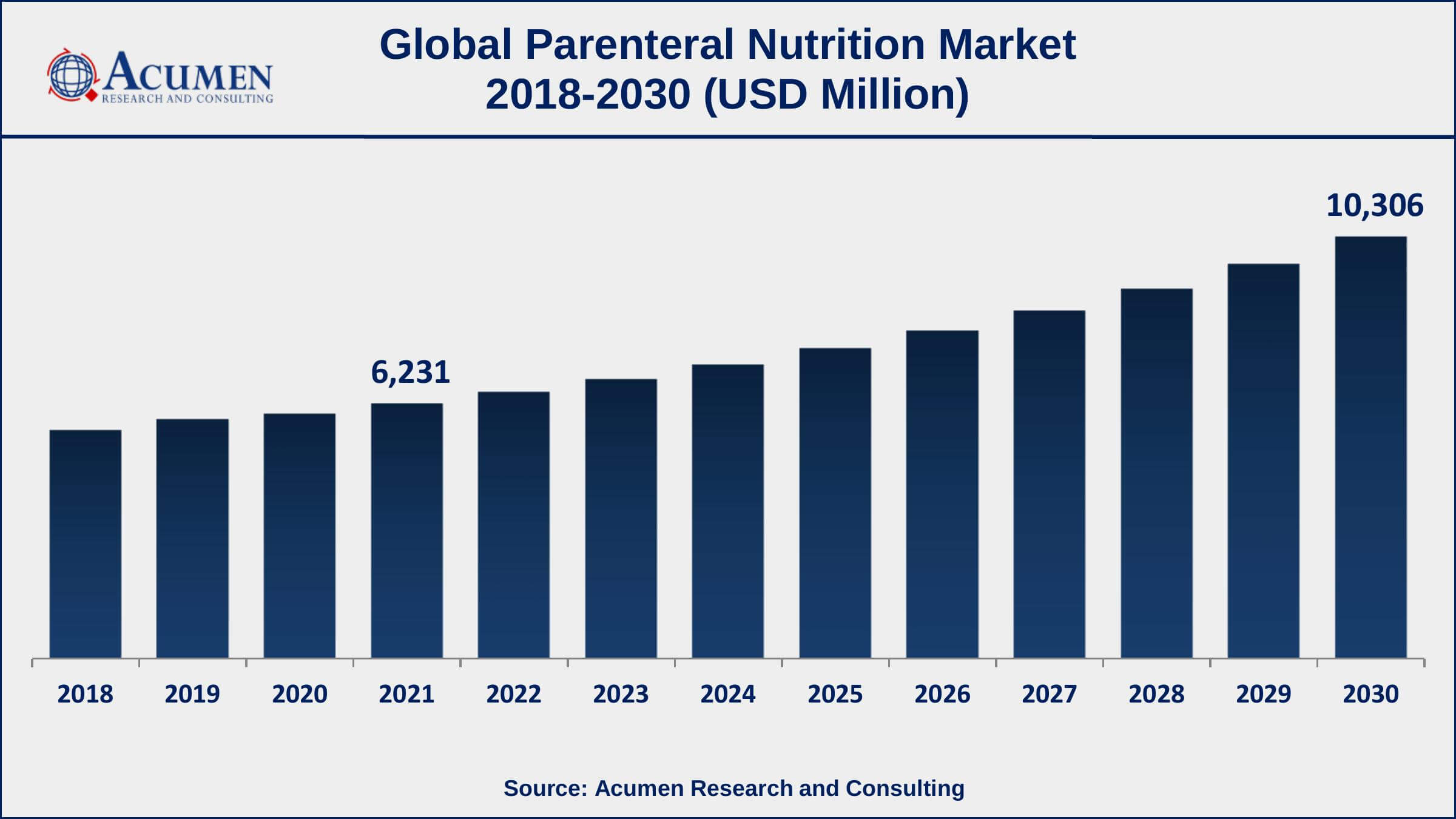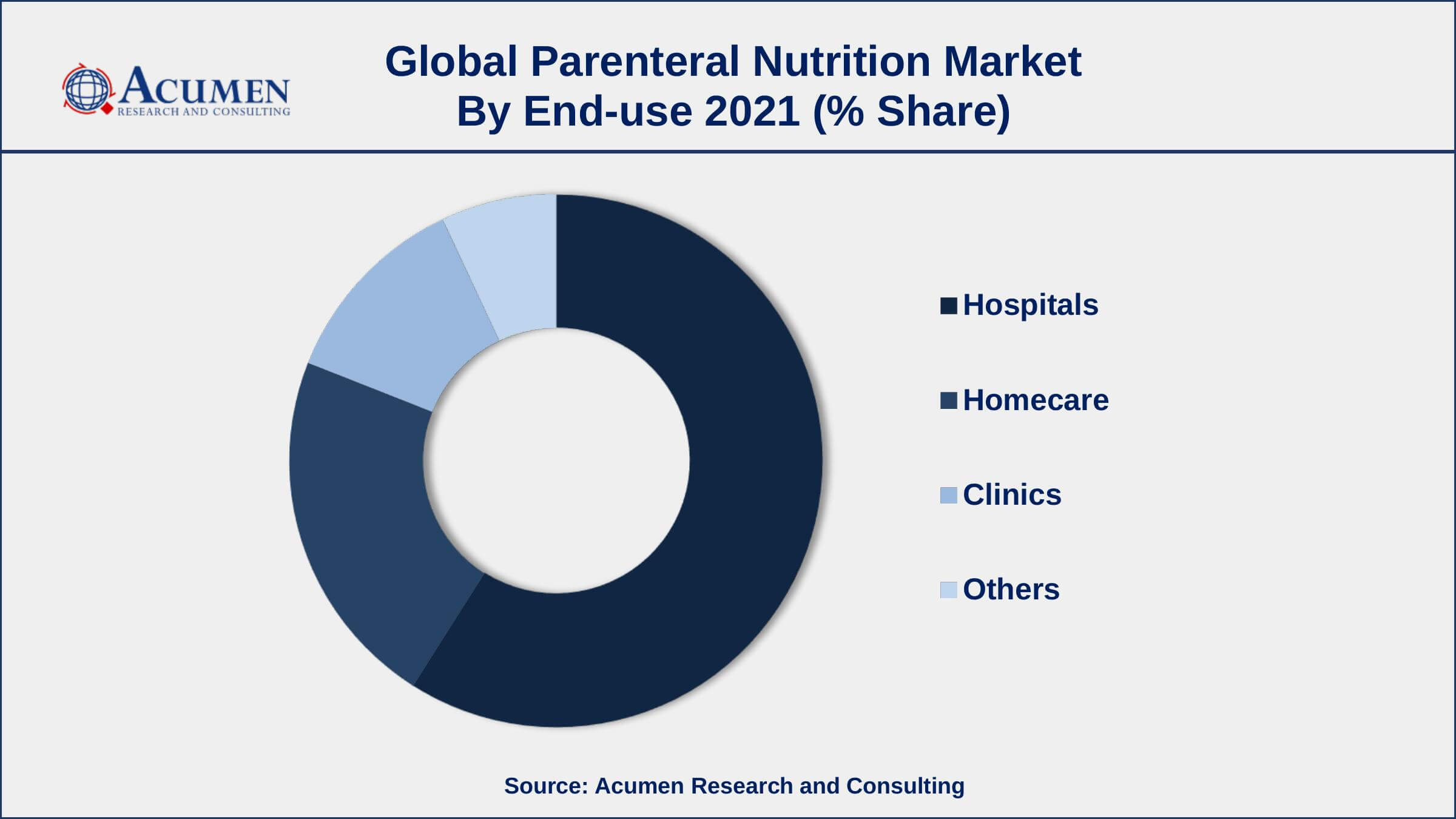Parenteral Nutrition Market | Acumen Research and Consulting
Parenteral Nutrition Market Size - Global Industry, Share, Analysis, Trends and Forecast 2022 - 2030
Published :
Report ID:
Pages :
Format : 
The Global Parenteral Nutrition Market Size accounted for USD 6,231 Million in 2021 and is estimated to achieve a market size of USD 10,306 Million by 2030 growing at a CAGR of 5.9% from 2022 to 2030. The rising frequency of childhood malnutrition is likely to drive the worldwide parenteral nutrition market growth. Furthermore, the growing number of government programs focusing on medical nutrition is expected to drive growth in the worldwide parenteral nutrition market value over the next few years.

Parenteral Nutrition Market Report Key Highlights
- Global parenteral nutrition market revenue is expected to increase by USD 10,306 million by 2030, with a 5.9% CAGR from 2022 to 2030
- North America region led with more than 39% of parenteral nutrition market share in 2021
- Asia-Pacific parenteral nutrition market growth will observe strongest CAGR from 2022 to 2030
- By nutrient type, the single dose amino acid solution segment has accounted market share of over 33% in 2021
- By consumer, adult segment engaged more than 58% of the total market share in 2021
- Increasing prevalence of metabolic illnesses, fuels the parenteral nutrition market size
Parenteral nutrition provides liquid nutrients such as lipids, proteins, minerals, carbs, vitamins, and electrolytes. It is a type of specialist medical nutrition therapy in which individuals that are unable to use their intestinal tract receive proper nutrition. It aids in the prevention of malnutrition as well as the maintenance of hydration, energy, as well as strength levels. As a result, it is commonly utilized among cancer, ischemic bowel disease, short bowel syndrome, Crohn's disease, and abnormal gut function patients.

Global Parenteral Nutrition Market Trends
Market Drivers
- Increasing prevalence of metabolic illnesses and other chronic conditions
- Rapidly expanding malnutrition across the globe
- Growth in the geriatric population
- Increasing rate of pre-mature birth & birth rate
Market Restraints
- Lack of clinical evidence to support innovative technology
- Inadequate awareness in undeveloped nations
Market Opportunities
- Increasing the number of product launches or clearances
- Increasing adoption of home healthcare in developed regions
Parenteral Nutrition Market Report Coverage
| Market | Parenteral Nutrition Market |
| Parenteral Nutrition Market Size 2021 | USD 6,231 Million |
| Parenteral Nutrition Market Forecast 2030 | USD 10,306 Million |
| Parenteral Nutrition Market CAGR During 2022 - 2030 | 5.9% |
| Parenteral Nutrition Market Analysis Period | 2018 - 2030 |
| Parenteral Nutrition Market Base Year | 2021 |
| Parenteral Nutrition Market Forecast Data | 2022 - 2030 |
| Segments Covered | By Nutrient Type, By Consumer, By End-Use, And By Geography |
| Regional Scope | North America, Europe, Asia Pacific, Latin America, and Middle East & Africa |
| Key Companies Profiled | Actavis, Inc., B. Braun Melsungen AG, Aculife (Nirlife), Sichuan Kelun Pharmaceutical Co. Ltd., Baxter International, Inc., Hospira, Inc., Grifols International S.A., Otsuka Pharmaceutical Factory, Inc., Fresenius Kabi AG, and Vifor Pharma. |
| Report Coverage |
Market Trends, Drivers, Restraints, Competitive Analysis, Player Profiling, Regulation Analysis |
The presence of a large number of malnourished children, high natality rate around the globe, increasing premature births, rising occurrence of cancer, which requires administration of vital nutrients to increase hydration, energy, and strength of cancer patients, and rising adoption by healthcare settings for the administration of nutrients in chronically ill geriatric patients are driving the market.
Malnutrition is one of the major drivers in the parenteral nutrition market. As per UNICEF, poor nutrition in infants in their initial 1,000 days may lead to impaired cognitive ability and stunted growth. An infant’s diet must contain a proper balance of vitamins, minerals, amino acids, starch, and lipids. These vital nutrients can be administered via parenteral nutrition, which is estimated to propel market growth.
Imbuement of lipid emulsions conveys high vitality supply, encourages the aversion of high glucose mixture rates, and is vital for the supply of basic unsaturated fats. Extension of the parenteral lipid emulsions section is because of its potential advantages to use as a medication conveyance vehicle. For example, the organization of lipid emulsions goes about as fundamental medication transporters, which results in decreased agony, aggravation, and anticipation of thrombophlebitis. Additionally, lipid emulsions containing a blend of medium and long-chain triglycerides (MCT/LCT) have ended up being exceedingly viable in basically sick patients. This blend of lipid emulsion does not hamper the working of the liver and causes an insignificant obstruction with aspiratory hemodynamics. As per the Society of Critical Care Medicine, 5.7 million patients are admitted to the emergency unit in the U.S. consistently. A large portion of these incorporates basically sick patients who need an abnormal state of intense consideration. Therefore, the rising number of basically sick patients is probably going to support the lipid emulsions section during the estimated time frame.
High commonness and ascend in the frequency rate of endless illnesses over the globe is a key factors driving the worldwide parenteral nourishment market. The ascent in malignant growth, AIDS, diabetes, Crohn's illness, gastrointestinal clutter, and short gut disorder cases have likewise fuelled the utilization of parenteral nourishment as of late. Consequently, the high predominance and considerable ascent in the occurrence rate of perpetual sicknesses over the globe is a key factor driving the worldwide parenteral nourishment market.

Parenteral Nutrition Market Segmentation
The global parenteral nutrition market segmentation is based on nutrient type, consumer, end-use, and geography.
Parenteral Nutrition Market By Nutrient Type
- Carbohydrates
- Trace Elements
- Single Dose Amino Acid Solution
- Parenteral Lipid Emulsion
- Vitamins & Minerals

According to a parenteral nutrition industry analysis, the single-dose amino acid solution segment held the biggest market share in 2021. This is due to a rise in the use of amino acid solutions, which is associated with a rise in the intake of regulatory-approved remedies. Furthermore, newly accessible amino acid solutions have fewer adverse effects, increasing patient advantages. Since mixed amino acid solutions contain both essential & non-essential amino acid residues, the conventional component serves as full parenteral for general biological functioning.
Parenteral Nutrition Market By Consumer
- Children and Newborns
- Adult
In terms of customers, the children and infants category is predicted to increase significantly in the market over the next few years. This growth is due to rising rates of premature birth in poor countries, rising child malnutrition, and other factors. Premature births are more common in emerging economies such as India, Indonesia, Nigeria, and the Philippines. Furthermore, the increasing frequency of chronic disorders such as congenital heart defects cystic fibrosis, and cerebral palsy, among others, has generated chances for important market competitors to engage.
Parenteral Nutrition Market By End-use
- Hospitals
- Homecare
- Clinics
- Others

According to the parenteral nutrition market forecast, the homecare end-use segment would increase rapidly in the industry over the next several years. The growing older population, increased patient desire for home-based care, growing desire for cost-effective medical care, and other factors are driving this growth.
Parenteral Nutrition Market Regional Outlook
North America
- U.S.
- Canada
Europe
- U.K.
- Germany
- France
- Spain
- Rest of Europe
Asia-Pacific
- India
- Japan
- China
- Australia
- South Korea
- Rest of Asia-Pacific
Latin America
- Brazil
- Mexico
- Rest of Latin America
The Middle East & Africa
- South Africa
- GCC Countries
- Rest of the Middle East & Africa (ME&A)
North America Dominates The Global Parenteral Nutrition Market
North America market ruled the general market in 2021, inferable from the nearness of high research consumption by government offices and private substances in the human services segment, mechanically propelled medicinal gadgets, and coordinated efforts among administrative experts, the restorative gadget industry, and colleges. In addition, the rising event of a few perpetual ailments, and the presence of cutting-edge social insurance offices, just as good repayment strategies have prompted an expansion in the emergency clinic confirmation that is foreseen to support the use rates in this district.
The parenteral nourishment market in the Asia-Pacific is anticipated to grow at an outstanding CAGR of 7.9% amid the figure time frame. The high pervasiveness of unending kidney issue in exceptionally populated nations, for example, China and India, quick improvement in social insurance framework, increment in access to medicinal services offices and ascend in per capita human services use in the area are probably going to fuel the market in the Asia-Pacific amid the figure time frame. The extensive base of pharmaceutical organizations in nations, for an example, India, Japan, and China likewise drive the market in the locale. Rising economies and extension of pharmaceutical markets in nations, as an example, China, India, Indonesia, Singapore, Taiwan, and Thailand are relied upon to move the market in the Asia-Pacific. Rising instances of preterm birth, which prompts unhealthiness, is a key reason fuelling the utilization of parenteral sustenance in the Asia-Pacific.
Parenteral Nutrition Market Players
Some of the top parenteral nutrition market companies offered in the professional report include Actavis, Inc., B. Braun Melsungen AG, Aculife (Nirlife), Sichuan Kelun Pharmaceutical Co. Ltd., Baxter International, Inc., Hospira, Inc., Grifols International S.A., Otsuka Pharmaceutical Factory, Inc., Fresenius Kabi AG, and Vifor Pharma.
Frequently Asked Questions
What is the size of global parenteral nutrition market in 2021?
The estimated value of global parenteral nutrition market in 2021 was accounted to be USD 6,231 Million.
What is the CAGR of global parenteral nutrition market during forecast period of 2022 to 2030?
The projected CAGR parenteral nutrition market during the analysis period of 2022 to 2030 is 5.9%.
Which are the key players operating in the market?
The prominent players of the global parenteral nutrition market are Actavis, Inc., B. Braun Melsungen AG, Aculife (Nirlife), Sichuan Kelun Pharmaceutical Co. Ltd., Baxter International, Inc., Hospira, Inc., Grifols International S.A., Otsuka Pharmaceutical Factory, Inc., Fresenius Kabi AG, and Vifor Pharma.
Which region held the dominating position in the global parenteral nutrition market?
North America held the dominating parenteral nutrition market during the analysis period of 2022 to 2030.
Which region registered the fastest growing CAGR for the forecast period of 2022 to 2030?
Asia-Pacific region exhibited fastest growing CAGR for parenteral nutrition market during the analysis period of 2022 to 2030.
What are the current trends and dynamics in the global parenteral nutrition market?
Increasing prevalence of metabolic illnesses and rapidly expanding malnutrition across the globe drives the growth of global parenteral nutrition market.
By end-use segment, which sub-segment held the maximum share?
Based on end-use, hospitals segment is expected to hold the maximum share of the parenteral nutrition market.
Select Licence Type
Connect with our sales team
Why Acumen Research And Consulting
100%
Customer Satisfaction
24x7
Availability - we are always there when you need us
200+
Fortune 50 Companies trust Acumen Research and Consulting
80%
of our reports are exclusive and first in the industry
100%
more data and analysis
1000+
reports published till date


